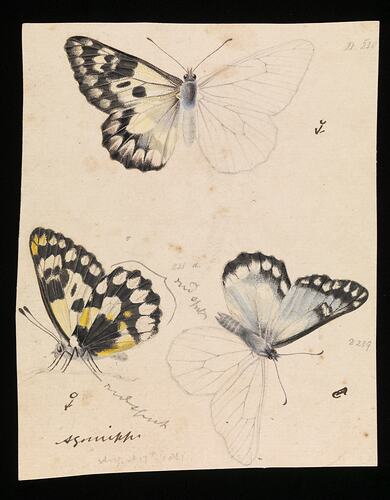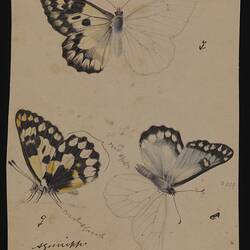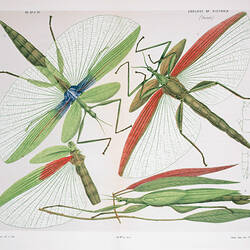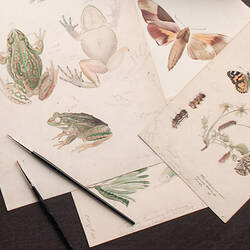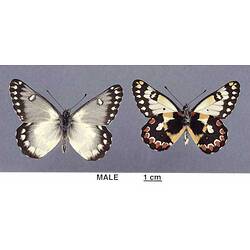Summary
Watercolour, pencil and ink illustration of a male (D238) and female (D239) Red-spotted Jezebel Butterfly, Delias aganippe, by Arthur Bartholomew, 17 August 1861. This work was commissioned by Frederick McCoy, the first Director of The National Museum of Victoria, for Plate 10 in The Prodromus of the Zoology of Victoria; Figures and descriptions of the living species of all classes of the Victoria indigenous animals. McCoy referred to this species as Pieris (Thyca) aganippe.
This illustration forms part of the much larger Prodromus Collection. Many of the original illustrations and prints in the collection informed the production of The Prodromus, the first major publication of the National Museum of Victoria. Between 1878 and 1890, McCoy published his zoology 'Prodromus' as 20 parts in two volumes, with each part comprising 20 Plates. Unfortunately, almost 90 plates in the collection remain unpublished, and hundreds of illustrations were either not completed or not printed.
Bartholomew had been hired as McCoy's attendant at the University but McCoy obviously saw Bartholomew's potential for the ambitious projects which lay ahead and he soon began both a zoological and geology series for McCoy which would form the basis of the Prodromus of the Zoology of Victoria and Prodromus of the Palaeontology of Victoria. During the following four decades he illustrated more than 700 zoological specimens, along with an as-yet undocumented number of palaeontology and geological specimens. He also was commissioned to produce diagrams for the medical school. Having trained as a lithographer, Bartholomew also transferred many illustrations, both his own and those of other artists, onto stone for the production of lithographs.
The Prodromus project followed a popular formula of the time, seeking to identify and classify the natural wonders of the 'new world'. Such publications reached a peak in popularity with the work of John Gould in England and the earlier work of James Audobon in America. In Australia, many professional and amateur publications, including Aldine's systematic studies of the colonies and Louise Anne Meredith's Bush Friends From Tasmania, contributed to the genre.
The publication of the Prodromus was an enormous undertaking, utilising the work of numerous artists, collectors, lithographers and publishers, over an extended period of time. Although costly in both financial and professional terms, it was met with critical acclaim and wide popular support. Financial battles were waged and lost by McCoy, but ultimately the Prodromus has stood the test of time and remains one of Museum Victoria's finest publications. McCoy died without completing his systematic study, but even at the time few believed that 'any of us will live to witness the completion of the work, if the entire Fauna of Victoria is to be illustrated.'
Description of Content
Wood White Butterfly, Delias aganippe (Donovan) by Arthur Bartholomew. Drawing, pencil, water colour, ink and varnish on paper, 17 Sept 1861, 13cm x 11cm. Drawing for Plate 10 in The Prodromus of the Zoology of Victoria by Frederick McCoy.
More Information
-
Collection Names
-
Collecting Areas
-
Artist
-
Medium
Pencil, watercolour, ink and varnish on paper
-
Technique
Scientific illustration
-
Plate Number
10
-
Drawing Number
D238 and 239
-
State
Illustration
-
Primary Inscriptions
August 17 1861
-
Secondary Inscriptions
D238, D238a. {re spots / re spot.. D239
-
Tertiary Inscriptions
[Another hand] Aganippe
-
Classification
-
Taxon Name
-
Author and date of publication
(Donovan, 1805)
-
Preferred Common name
Red-spotted Jezebel Butterfly
-
Other Common Names
Wood White Wood White Butterfly Spotted Jezebel
-
Kingdom
-
Phylum
-
Subphylum
-
Class
-
Subclass
-
Superorder
-
Order
-
Suborder
-
Superfamily
-
Family
-
Subfamily
-
Genus
-
Species Name
aganippe
-
Category
-
Discipline
-
Type of item
-
Overall Dimensions
11 cm (Width), 13 cm (Height)
-
References
[Book Series] McCoy, Frederick. 1878-1890. Natural History of Victoria: Prodromus of the Zoology of Victoria or Figures and Descriptions of the Living Species of All Classes of the Victorian Indigenous Animals. 1-2.
[Article] Yen, Alan L., et al. 2001. McCoy's Prodromus of the Zoology of Victoria: an unfinished task. Vic. Nat. 118 (6): 242-255.
